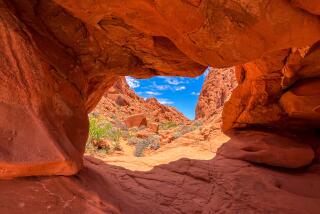Through the Everglades on the Old Tamiami Trail
EVERGLADES CITY, Fla. — In the land of the snapper, the snook, the skipjack and the pompano, the fish are jumping and the saw grass is high. They went out and built a high-speed toll road, and now the Tamiami Trail is deserted.
After nearly 60 years of service, old U.S. 41 across the Everglades is a ghost road. Alligator Alley has taken its place--wider than Daytona, fast as a bullet and easy on your bottom.
As we begin, our wheels are on Bayshore Drive in Miami and our eyes are on Biscayne Bay. A crabber is pulling out of port, a pleasure boat rests at peace in the harbor and in the distance two mystery vessels go about their business. Behind us the road sign says: “U.S. 41 North, Tamiami Trail.”
Heart of Miami
We drive for two miles, and we leave the country. We’re on Calle Ocho, the main street of Little Havana in the heart of Miami. We can tell by the courtly old gentlemen promenading by in ice cream suits, by the strolling tunas singing plaintive ballads, by the murals of the homeland brightening street corners.
We can buy anything we want, as long as it’s a guitar, a candle, a lace mantilla, a bullfight poster or a pinata.
We detour to our left at the monumental Prado gate to Coral Gables. Built during the first 20 years of this century by architects who marched to the beat of a different drummer, Coral Gables looks like no other city in the world. Its landscaped parkways are so broad that you had better carry a canteen if you plan to cross the street, and its estates fall somewhere between rococo and churrigueresque.
We park at the corner of Granada Boulevard and Avenida Sevilla to check out the Venetian Pool, listed in the National Register of Historic Places and surely the nation’s most lavish public swimming pool. Its emerald waters lap through naturally formed lagoons and grottoes of what was once a quarry.
Now we head south to Ponce de Leon Boulevard and pull into the University of Miami’s Gate 4, where visitors can park all day without a permit. The university, home of college football’s No. 1-ranked Hurricanes, has long had a reputation as a party school. It recently raised its admission requirements to dispel this image. Nonetheless, it looks like a party school. Students cruise the campus in Corvettes and Porsches and set up dates by car phone.
We return to the trail. Settlements thin out, the road narrows to two lanes and now we are in the wilderness. Between Miami and Naples we have the Tamiami Trail to ourselves: 106 miles of spectacular scenery, wild swamp rides, funky little ghost towns and not-so-funky innkeepers who will be thrilled to see us.
We pass through saw-grass marshes with here and there a stand of pines on a hammock, an island in the swamp. Herons skitter along the Tamiami Canal to our right, and kites swoop down for garfish and bream.
Catfish With Pumpkin Bread
Twenty-five miles from Miami we stop at the Miccosukee Indian Village for lunch. Menu choices range from catfish to frog legs, served with pumpkin bread or Indian fry bread.
For $11 we get a guided tour of the village and a half-hour airboat ride deep into the heart of the Everglades.
An airboat has a shallow draft and, in back, two auto engines that drive an airplane propeller. The Miccosukees supply us with cotton to stuff in our ears, and we’re off.
At first we’re simply aware of plowing through the waterways at high speed, but suddenly our pilot veers off toward a nine-foot-high forest of saw grass and we cover our eyes. Then, remarkably, we find that we’re still sailing through water. We’re leaving a wake.
The Everglades, we learn, is not a stagnant swamp at all but rather the world’s widest, shallowest, slowest-flowing river. Fifty miles wide and six inches deep, the Everglades flows from Lake Okeechobee in central Florida to Florida Bay at the state’s southern tip.
Midway between Miami and Naples the scenery begins to change. We enter Big Cypress National Preserve. Tall cypresses rise on the hammocks amid the saw-grass marshes, huge buttresses branching from their trunks, bending at the knees and plunging into the water. High in the sky, up to 170 feet, a delicate tracery of feathery foliage arcs against the clouds.
Presidential Stopovers
At Carnestown we visit the Everglades Area Chamber of Commerce. Jay Craven recommends the Rod & Gun Lodge four miles down the road in Everglades City. “Truman and Eisenhower used to stay there,” he says.
First, though, we stop at Eden of the Everglades, one man’s dream of bringing the beauty of the Everglades to the world. Ervin Stokes (“Call me Jungle Erv”) owns eight acres of swampland along Panther Creek, a waterway so still and clear that it reflects every mangrove stand at its banks.
Jungle Erv built a cypress boardwalk over the swamp. The boardwalk takes us past green-wing macaws, cockateels, African ringnecks, Moluccan cockatoos, blue-mask lovebirds, toucans, tortoises, alligators, bobcats and a panther.
For city slickers, the mangrove branches are too close for comfort. We’ve seen a lot of movies, and we know that the straggler always gets a snake around the neck. So we hurry to the pier for a ride aboard the Everglades Jungle Queen.
“See those alligators at 1 o’clock?” asks Jungle Erv. No, we don’t, not until we’re right on top of them. He spots a big kingfish long before we do, and chicken snakes and white ibises and brown ibises. “I see a manatee,” one passenger exults. “Plastic bag,” Jungle Erv says.
Not Quite Right
We head for the Rod & Gun Lodge for dinner. What was good enough for Eisenhower and Truman is good enough for us. When we see it, though, we get the feeling that something is not quite right. The landscaping is untended, and the timbers of the huge old mansion are askew. Only four cars are parked in front, and they look abandoned.
A buoyantly friendly young woman greets us at the door. We walk through an enormous lobby paneled in cypress and bursting with hunting and fishing trophies. Plump old wing chairs sit empty around a massive hooded fireplace. The woody, masculine bar is well-stocked with all the ingredients for yesterday’s cocktails, but there is no bartender.
The young woman leads us through a formal dining room, hung with giant brass chandeliers, and out to the screened veranda. A waitress flitters out to hand us menus.
We are the only customers.
“Is business always like this?” we ask our waitress.
“No,” she answers. “It gets real slow in the summer.”
The grilled fresh grouper, with salad, is $10.50 and terrific.
On the way out, we stop at the desk for a brief chat with the desk clerk. He’s about 11. “How much is a room here?” we ask.
“I think it’s $44.10,” he says.
The Other Hotel
There’s something depressing about a deserted hotel, so we check into the other hotel in Everglades City, the Captain’s Table Resort. It used to be a train station, but the train doesn’t stop here anymore.
This time the desk clerk is old enough to vote, and she greets us so cheerfully that we decide to stay. Our room is $38 a night, with air conditioning, color TV and a balcony overlooking the parking lot (seven cars, two pickups).
Like the Rod & Gun Lodge, the Captain’s Table has a marina, and we wish we were fisherfolk. But the last time we cast our lines in public we caught the hook in our collar, and the tiny squid that was our bait went down our back. All the other guys laughed at us.
The next morning we board the Manatee at the ranger station at the entrance to Everglades National Park. We cruise Chokoloskee Bay, where the fresh water of the Everglades mingles with the salt water of the Gulf of Mexico, and our captain tells us the sad tale of Everglades City.
It was a booming resort once, he says. Richard Nixon used to go there, and so did Warren Earl Burger, later to become chief justice of the United States. But in 1959 the privately owned lands around Everglades City were donated to the government to become part of the national park, which meant that hunting was now illegal. Then, in 1960, Hurricane Donna came to town and buried the city under eight feet of mud, and it never recovered.
County Seat Moved
The Collins County seat was moved from Everglades City to Naples, our destination. Naples is the queen of the Tamiami Trail and its western terminus. The trail proceeds north to Tampa, but as an inland feeder road it’s of little interest to adventurers.
Favorite Town
Naples, however, is every Floridian’s favorite town. Immaculately manicured, a planned city with a rigorous zoning code, it has become known as a retirement haven for millionaires. In fact, there’s room for the rest of us too. The Best Western Buccaneer Inn on the Tamiami Trail charges $29 a night, including refrigerator, hot plate, dishes, teapot, coffee and eating utensils.
We can dine off paper plates with what passes in Florida for the younger set at the Riverwalk Fish & Ale House, $7.95 for chicken parmigiana with linguine and $3.95 for a carafe of Taylor California Cellars Chablis, with a beautiful view of Naples Bay. After a second carafe, we can see Capri.
And the sunsets over the Gulf of Mexico are free. We drive to the end of 7th Avenue North and park at the edge of the sand. Pelicans await the event atop rows of pilings. We drink a Coors Light.
Sixty years ago it took 2.6 million sticks of dynamite to raise the Tamiami Trail out of the swamp. For today’s traveler, it’s still a blast.
More to Read
Sign up for The Wild
We’ll help you find the best places to hike, bike and run, as well as the perfect silent spots for meditation and yoga.
You may occasionally receive promotional content from the Los Angeles Times.






